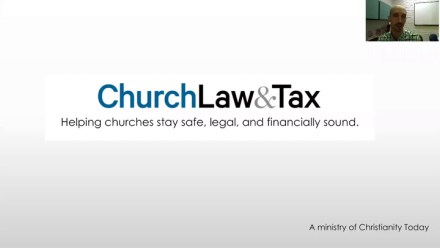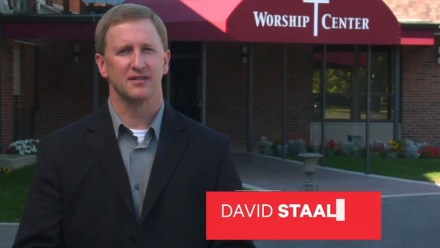
Planning Your Pastor’s Retirement
Webinar Recording: What you need to create and follow a successful retirement plan.

Webinar Recording: What you need to create and follow a successful retirement plan.

And how to find which ones don’t need to be presented.
You’ve most likely been in meetings that drag on forever because of unnecessary committee reports. There is good news straight from the parliamentary procedure powers that be: you do not have to include “Time-Wasting Committee Reports” on your meeting agenda.
A “Time-Wasting Committee Report” is given dedicated space on the agenda to describe a committee’s activities, even though the committee doesn’t have any items to present for action.
You don’t need Robert’s Rules to tell you these reports are eating up precious minutes during meetings. But parliamentary procedure can give guidance on how to tactfully, responsibly pare down the unnecessary verbal reports.
The first step to remove time-wasting committee reports from the agenda is to ask each committee to submit an official written report and a completed committee activities form at least one day prior to when staff prints the agenda and meeting materials.
The committee activities form is a one-page summary of who’s been doing what (recently). The form is simple to fill out and only asks the committee to state the following information:
Simply put, the Committee Activities Form is an at-a-glance method of determining which committees need a place on the agenda—and it simultaneously functions as a method of seeing which committees are actually functioning.
Once you have a Committee Activities Form for each committee, the second step to removing time-wasting committee reports from the agenda is to review the forms and give dedicated space on the agenda only to committees that have actions items to present to the entire group.
The rest of the reports should be printed for distribution at the meeting (or loaded to an internal website) so members can read them on their own time. Similarly, at the meeting, the committees that are placed on the agenda can simply rise and present the action items they’ve listed, leaving the rest of the report to be read later at members’ leisure.
Even without any action items to present for a group decision, reports of committee activity are still important. My goal is certainly not to diminish the good, hard work that committees perform for any well-functioning organization. Sometimes active committees do need to be on the agenda, even without any action items: especially when they have vital information to communicate. But the status quo in many organizations is to allow all committees time to report, with little thought for the effect reports have on the length of the meeting and the valuable time of dedicated members.
Before your next meeting, give some thought to your agenda and consider whether you can do just fine without a verbal presentation from every committee.

This action could create taxable income in the amount by which the property’s fair market value exceeds the bargain sale price.
Last Reviewed: October 8, 2025
Q: Our pastor will soon retire after 30 years of service to our church. The pastor and his wife have resided in our church parsonage for all of these years, and the church board would like to sell the parsonage to the pastor at half of its market value as a retirement gift in recognition of his services.
Some board members believe that the difference between the market value of the parsonage and the sales price must be reported as taxable income by the church on the pastor’s W-2, but others disagree. How should we handle this?
A: If a church allows an employee to buy church property at less than fair market value, the employee ordinarily realizes taxable income in the amount by which the property’s fair market value exceeds the bargain sale price (Treas. Reg. 1.61-2(d)(2)).
This assumes that the property is owned by the church debt-free, or that the church remains responsible for any indebtedness.
Access the entire Church & Clergy Tax Guide online when you upgrade to an Advantage Membership—and get a 20% discount off all future purchases at ChurchLawAndTaxStore.com!
Before making a bargain sale of church property to an employee, a church must also consider whether the employee’s total compensation is unreasonable in amount. If it is, this may constitute prohibited inurement of a church asset to the personal benefit of a private individual in violation of one of the conditions for tax-exempt status listed in section 501(c)(3) of the tax code.
Such a sale also may also expose the retired minister and members of the church board to substantial excise taxes known as “intermediate sanctions.”
For these reasons, be sure to check with a tax professional before approving a bargain sale of church property to a church employee.

Discover practical fraud prevention strategies to protect your church and maintain trust.
Last Reviewed: January 25, 2025
Nathan Salsbery is a partner and executive vice president with the accounting firm CapinCrouse. As the son of a pastor and the son-in-law of a retired FBI agent, it’s perhaps no surprise that he’s become an expert in forensic accounting and rooting out fraud in churches. We asked him to talk about his forensic accounting work and offer insights for identifying and preventing fraud in churches.
Fraud is a serious issue in many churches. Understanding fraud prevention in church operations is essential to protect funds, maintain trust, and reduce risks. Learn how to safeguard your church through effective practices and oversight.
Fraud: A broad term encompassing asset misappropriation, fraudulent reporting, and corruption. Embezzlement: A subset of fraud, involving asset misappropriation such as theft of cash or misuse of resources.
Forensic accounting uses professional skills to uncover fraud. Experts analyze areas of risk, gather evidence, and help leadership decide on corrective actions. Findings may be used in litigation if necessary.
Unusual expenses, missing funds, or single-person control over finances are common red flags.
Engage volunteers to oversee offerings, establish accountability, and review financial statements regularly.
While not required, it can help uncover fraud and provide evidence for legal actions if needed.
High-trust environments and lack of financial oversight make churches vulnerable to fraud.
Fraud prevention in churches requires vigilance, proper controls, and clear oversight. By adopting robust policies and monitoring processes, churches can safeguard their resources and maintain the trust of their community. For more resources, visit Church Law & Tax.

What the Good Samaritan parable can teach us abut helping after hurricanes and other disasters.
“Good Samaritan” is a common term used to describe volunteers who go above and beyond to help after a disaster. There’s even a Good Samaritan law in every state to help protect uncompensated volunteers spontaneously providing aid in emergency situations.
The parable of the Good Samaritan, from which this term gets its name, is one of the most told and taught parables in the Bible. Found in the Gospel of Luke (Luke 10:25-37), it offers an example of how to love God, embrace strangers as neighbors, and help others in need.
A closer look at the Good Samaritan parable can provide inspiration and guidance for Christians seeking to help in the wake of disasters.
Before volunteering, stop and ask yourself why you want to help. The telling of the Good Samaritan parable was sparked by an interaction Jesus had with an expert of the law. This expert wanted to know how to earn eternal life. Jesus redirected the conversation, shifting his thinking from “What’s in it for me?” to “How can I love God and others well?”
Help because of your faith, not to prove your faith.
Disaster relief is not about you. Volunteer to meet the needs of survivors, not to satisfy your own extrinsic needs (e.g., to be seen as a do-gooder). Make sure you are helping for the right reasons. Good reasons for wanting to help should be inwardly motivated: you want to help others for the sake of helping others. You want to help because you believe it’s the right thing to do.
Reach beyond your comfort zone; focus especially on helping underserved and vulnerable neighbors affected by hurricanes. Don’t cross to the other side of the road, like the priest or Levite, if you encounter someone in need whom you perceive to be different than yourself.
Disasters impact those with fewer social or economic resources more significantly. Because they have fewer resources at hand, it also makes recovery typically longer and more difficult.
Following the Good Samaritan’s example means broadening your notion of “neighbor” beyond shared geography and backgrounds.
You are called to show compassion to all people, regardless of religion, class, or difference—not just survivors you might easily identify with or relate to.
Reach out to help people living with major challenges: those in poverty, the medically fragile, the elderly, immigrants.
For example, some immigrants and refugees may live in fear of deportation, and as a result, they might not ask for the help they need to rebound.
Elderly people in high crime areas live in fear of being harmed and may not open their doors to people they don’t know, even if those people are trying to help them survive.
People living in poverty may not have the resources to evacuate and get to safety when that means paying for extra gas and a hotel.
Empathize.
To love your neighbor in the wake of hurricanes, start by empathizing with what they are going through. When the Samaritan saw the injured man beaten by robbers, he connected with the man’s suffering. It’s common for disaster survivors to feel alone or isolated—like no one else understands their experience. Create space for them to lament what they have gone through.
Another way you can empathize with survivors is through prayer. As people of faith, we are called to pray for others, especially for those in need, and prayer is one of the most powerful ways we can help.
Meet basic needs.
The Good Samaritan took care of the man’s most immediate physical needs by bandaging his wounds, helping him to an inn, and taking care of him through the night.
Focus on attending to survivors’ most basic needs, like injuries, transportation, shelter, and safety.
Remember: Aid happens where needs meet resources.
Don’t assume you know the best way to help or what your neighbor needs.
Instead, ask how you can help and what your neighbor’s most immediate and tangible needs are—then take steps to try and help meet those needs.
Give financially.
Research has shown the vast majority of giving is done in the early phase of disaster response and often runs dry during later stages of recovery. Commit to supporting long-term assistance, as social and financial capital often dry up well before tangible signs of disaster recovery are evidenced.
The Good Samaritan gave two denarii to the innkeeper to help the man while he was gone. He informed the innkeeper of his plan to come back and cover expenses incurred in his absence.
Another way you can help like the Good Samaritan is to financially contribute to recovery efforts. Note that the Good Samaritan anticipated more resources were likely to be needed as time passed. Giving money now is one of the most effective ways you can help in the immediate aftermath of natural disasters.
Yes, giving a monetary donation can feel a bit sterile. Yet giving to those on the ground means your dollars will be utilized immediately and where they are most needed. To make sure your dollars go to work, give to established relief organizations and nonprofits.
Jamie Aten (@drjamieaten) is founder and executive director of the Humanitarian Disaster Institute at Wheaton College, Illinois, and author of the Disaster Ministry Handbook. In 2016 he received the FEMA Community Preparedness Champion award at the White House. Read more at jamieaten.com.

Before a hurricane strikes, your church can take a variety of proactive steps to reduce and minimize the risk of damage.
Last Reviewed: September 10, 2024
Before a hurricane strikes, you can help prepare your church property in various ways to reduce and minimize disaster risk and damage.
The path of destruction and the fallout caused by disasters can be random. Despite planning and mitigating preparations, there may be times when no course of action could have prevented property damage.
There are other cases in which churches—seemingly miraculously—go unscathed or experience just minor damage.
Regardless, you should still take precautions where you can to enhance your property’s ability to weather adversity. You should prepare your church to the best of your abilities and resources, as though your church will be the one still standing after the storm. Doing so will better position your church to continue to minister to those around you once that storm passes.
Here are several strategies you can implement to help get your church property ready, as well a worksheet to help guide your preparedness efforts.
The following steps are taken from a FEMA guide and are examples of easy-to-implement, low-to-no-cost mitigation steps.
Note: these steps are examples of ideal ways to prepare, but they should only be implemented if you have time to prepare before the disaster strikes. Don’t try them if doing so will put you or others in danger, and take evacuation notices seriously.
Though you may be anxious to see the condition of your property, do not return to it before local officials have determined the area is safe.
Carefully go around the outside and look for loose power lines, gas leaks, and structural damage. If there is any doubt about safety, have your facility inspected by a qualified building inspector or structural engineer prior to entering.
Once it is safe to enter your property, you should take any steps you can to prevent further loss or damage:
After major disasters, most people who come in to help repair damage mean well and truly want to help. Others, however—including fake companies—may respond in order to take advantage of people, including churches. One pastor I interviewed after Hurricane Katrina said that a “construction company” offered to repair their church roof, but they needed payment up front. Long story short: once the money exchanged hands, the construction company never returned. When the church tried to track down the company, they found out that the company didn’t really exist.
INSTRUCTIONS: Provide some basic building data by completing the line items below. The emphasis should be on information that may be helpful to your congregation leadership as well as outside sources, such as emergency services personnel.
Facility Features
|
Occupancy type (church, office building, etc.): |
|
Total square footage: |
|
Year built/date of most recent renovation: |
|
Number of stories (is there a basement?): |
|
Type of construction: |
|
Insurance company: |
|
Describe any unique features (inside or outside): |
NOTE: Attach any floor plans of the facility at the end of the document.
INSTRUCTIONS: Find (or purchase or ask others to donate) these items in your church building. Document where the items can be found and check to make sure they are working properly. Keep this list up to date to ensure resources remain available and are working properly.
Emergency Supplies and Equipment Locations:
Portable radios and extra batteries:
Emergency first-aid supplies:
Flashlights and extra batteries:
Stored drinking water:
Emergency (three-day) food supply:
Basic tool kit:
Fire alarm system:
Location of fire alarm:
Location of fire extinguishers:
If system monitored by outside agency, name and phone:
Sprinkler system (water flow valves and standpipes, including tamper alarms):
Exits: information on fire escapes (type and location):
Information on fire doors (if applicable):
Utility Shutoffs and Tools
Main gas valve:
Crescent wrench or gas shutoff tools:
Main water valve:
Electrical fuse box/circuit breaker:
Emergency or portable generator (if applicable):
Inventory of Neighborhood Resources
Where can you rent or borrow a generator?
Where is the nearest medical treatment facility? (Attach driving and walking directions.)
Where is the nearest fire station?
Where is the nearest police station?
Where can you go for additional water?
Where can you go for additional food supplies?
Where can you go for additional medical supplies, medicines, and special equipment?

The secret to making meetings brief and efficient.
No one likes sitting in a meeting any longer than necessary. So here’s the best kept secret for shortening a meeting: bypass debate on non-controversial motions.
Not all motions or topics need to be discussed. Sometimes—more often than you might think—members of a board, committee, or even a larger group are already in agreement. Why waste time with needless debate in that case? Save everyone’s energy, and simply put the matter to a vote.
To be clear, if your rules permit discussion on a motion, the presiding officer or president must allow it. But allowing it and explicitly asking “Is there any discussion?” are two different things.
There are two primary ways to bypass discussion on a motion while still technically “allowing” for it. Key point: both require the presiding officer or president to have a firm handle on the agenda and the topics set to come before the group.
Use unanimous consent, also known as general consent. If a presiding officer knows in advance that an agenda item is entirely non-controversial (and some are), she should use unanimous consent to move directly to a vote on that topic.
For example, to take a unanimous consent vote on approving the previous meeting’s minutes, the presiding officer would say, “If there is no objection, the minutes are approved.” The alternative is to ask for a motion, second, and discussion on approving the minutes, and then to say, “All those in favor of approving the minutes say, ‘aye.’ . . . All those opposed say, ‘no.’” Do you see how the unanimous consent method saves time?
Of course, if the presiding officer is mistaken about the consensus, and a member does want to discuss the topic, that member can simply object by saying “I object” during the unanimous consent vote. This forces the presiding officer to ask for discussion and take a vote that seeks a response both from those in favor and those in opposition.
Clarify who is in favor and who is opposed. In small groups, this happens by a show of hands. The presiding officer can simply ask, “Who would like to speak in favor of/opposition to this motion?”
When a presiding officer sees that the members who want to discuss are from only one side (pro or con), she should gauge the group’s interest in having a discussion at all. For example, she could say, “I see that the only members lining up for debate are in favor of the motion. Is there anyone who would like to speak in opposition? [Pause] If not, is there any objection to dispensing with discussion and moving directly to a vote?”
Sometimes a group will want to hear from everyone, even if they are all on one side of an issue, but more often than not the members will see the time-saving advantage of moving directly to a vote.
Bottom line: do your members a favor by ascertaining in advance which topics can be put to a vote without discussion. You’ll be surprised how quickly your meetings will move along!

From mission trips to maintenance work, accidents happen. Learn why workers’ compensation insurance is crucial for churches.
Last Reviewed: January 31, 2025
Ministry can be a surprisingly hazardous profession.
Just ask Luke Trouten.
Back in 2010, Trouten, a youth pastor at Northwood Church in Maple Grove, Minnesota, was on a missions trip with junior high students when they decided to cool off at a local park.
Things went well till Trouten fell off a ledge and busted his leg.
“I ended up with some rods and screws and all kinds of things,” he said. “Didn’t walk for almost a year.”
Fortunately for Trouten, workers’ compensation covered all of his medical bills—including a couple of surgeries and a long hospital stay.
The process, at least as far as paperwork went, was fairly simple. The church’s office manager took care of contacting the insurance company. Once the company determined Trouten was working when he was injured, his bills were covered.
Accidents like Trouten’s aren’t that uncommon.
Staff and volunteers get hurt at church all the time, said Bill Mech, assistant vice president for health services and workers’ compensation at GuideOne Insurance, a company that specializes in insuring churches.
That’s in part because churches do a lot—from youth-group trips and kids programs to church work days and community concerts. And church staff can throw out their backs while picking up a box or volunteers can trip and fall, just like they do at any other workplace.
Then there’s the tendency for church staff and volunteers to do things themselves because finances are tight. So they may take a few more risks.
“There are a lot of times when a pastor gets up on a ladder and bad things happen,” Mech said.
Workers’ compensation rules are set by each state. In many states—such as Illinois, Colorado, and Michigan—any organization with more than one staff person has to have workers’ compensation insurance. For the most part, churches are required to purchase it for their employees. A few states, like Texas, allow churches and other organizations to opt out of workers’ compensation. Also, most states draw a clear line between employees and volunteers, but a few, such as California, allow volunteers to be covered by workers’ compensation—more on this later. (To find workers’ compensation rules in each state, go to dol.gov.)
Still, there are advantages to having workers’ compensation insurance, even if it is not required, said Ryan Inzenga, an underwriting specialist for GuideOne.
“The injured worker can have their medical bills paid,” he said, “and the employer doesn’t have to worry about being sued.”
In general, the state laws that govern workers’ compensation prohibit employees from suing their employer if they are injured on the job, said Frank Sommerville, an attorney who specializes in legal issues facing churches and serves as an editorial advisor for Church Finance Today.
And churches are still responsible when an employee is injured, even if they don’t have workers’ compensation insurance.
“Even if a state allows churches to opt out, it’s probably not a good idea to do so,” said John A. Anthony, an attorney whose clients include churches, ministries, healthcare businesses, and physician practices. “Churches think if they do that, they are off the hook. But they are still responsible for what happens on their property and to their employees.”
There are more than 600 classifications for employees. Not all position classifications are treated the same, either—roofers, for example, are more expensive to cover under workers’ compensation than office workers.
Sommerville said churches can run into trouble by misclassifying workers in order to save money on premiums. He knows of churches that classified maintenance staff as office workers, since it’s less expensive to insure them—only to be hit with thousands of dollars in penalties.
“That should not have happened in the first place,” he said.
Some states allow insurance companies to add an endorsement in their policies that includes volunteers.
GuideOne’s Inzenga and Mech are skeptical about that approach.
For one, volunteers aren’t really employees, they pointed out, and so trying to cover them through workers’ compensation is complicated.
Unlike employees, volunteers are not restricted to making workers’ compensation claims if they are injured, Sommerville said. So they may still sue a church, even if an endorsement is in place.
Further, if churches use an endorsement, said Inzenga and Mech, they would likely have to keep track of every volunteer, including logging each volunteer’s hours and duties performed. That’s because the price of workers’ compensation insurance is tied to the size of an organization’s payroll. And since volunteers aren’t paid, insurance carriers need to estimate the value of the labor done by volunteers.
“In some cases, the church could be facing a 50 percent increase in the cost of their coverage,” Mech said.
One alternative is to add an accident policy for volunteers, which would cover volunteers injured while working at the church, suggested the representatives of GuideOne.
Jeffrey Szalacinski, vice president of claims for Church Mutual Insurance Company, said a church’s general liability policy can cover volunteers, and churches can also purchase policies that specifically cover injuries to volunteers.
Ron Smedley of California-based Employers Resource Associates believes that many churches have volunteers sign a waiver, agreeing to hold a church harmless if they get injured.
That approach may appear to be cost effective, he said, and some churches may feel they need to take that approach. But waivers can be challenged if someone is actually injured. And a waiver can create the perception that the church does not see their employees or volunteers as valuable.
In addition, as attorney Richard R. Hammar warns, waivers and releases often are viewed with disfavor by courts, and will not hold up when a situation involves gross negligence.
Rather than leaning on some sort of waiver, Smedley believes churches should strive to provide some form of insurance for injured volunteers. Churches should also be proactive about preventing injuries in the first place.
Churches should designate someone to serve as volunteer coordinator and put together a volunteer handbook that includes safety rules and procedures. The handbook should also outline a plan for responding when an accident or injury happens. It’s a way to practice good stewardship, Smedley said, and to show care and concern for the well-being of volunteers.
The goal should be to prevent injuries—and to help people recover if they are injured, he said.
Having the right safety policies and insurance coverage helps create an environment that demonstrates the church’s messages that God loves and cares for his people, Smedley said.
Szalacinski also stressed that churches should be proactive with preventing injuries. An approaching big event or missions trip is a good time to go over a safety plan, he said. And insurance companies that work with churches publish guides for how churches can avoid or reduce risk.
While churches need to be proactive about creating a safe environment for workers and volunteers, it’s very important that they also have the right insurance—just in case, Sommerville said.
“You are trying to keep your volunteers and your workers safe—but you also need the insurance in case bad things happen,” he stressed. “Because bad things can happen.”
In order to purchase the kind of insurance that’s best for your church, Sommerville said it’s crucial for a church to work closely with its insurance agent to audit its coverage. The more homework churches do, he said, the better price they’ll get.
Szalacinski recommended the same approach when exploring liability coverage for volunteers. And be sure to explain to your insurance agent all the different kinds of work that volunteers do at your church. The more your insurance agent understands about your church, the easier it will be to tailor a plan to meet your church’s needs and budget, he said.
Mech said most insurance companies have a minimum annual premium they charge, which can be as low as $500 to $1,000 for a smaller church. For a megachurch with many programs—such as a daycare, school, or camp—the premiums can reach six figures, he said.
If a church does have a workers’ compensation claim, their insurance may cost more. Mech said a claim in the vicinity of $5,000 can qualify for what’s known as an “eligibility rating,” and could cause rates to go up. It depends, in part, on the size of the church and how many claims are expected in a year.
If an employee or a volunteer gets hurt, it’s important to respond immediately and also take the injury seriously, Anthony said.
“You’d be shocked at how often someone says they’re fine when an accident happens at church,” Anthony said. “And then it turns out they were injured and need to file a workers’ compensation or liability claim.”
If someone gets hurt at church, make sure they get immediate assistance, Szalacinksi stressed, then report any injuries to your insurance company as soon as possible.
“The earlier those claims are reported, the quicker a claims representative can provide guidance to the church and to the injured worker or volunteer,” he said.
Three kinds of people generally work at churches, said Inzenga. There are employees, volunteers, and then independent contractors or “casual labor.”
Employees are paid staff, like pastors or office workers—those who generally qualify for workers’ compensation. Volunteers aren’t paid for their work—though they can be reimbursed for expenses or receive gifts, like meals, from the church. Then there are independent contractors—those who are hired to mow the lawns, fix the air conditioning, or do other tasks.
And what about a missionary? If a missionary speaks at a church and gets a “love offering” or other honorarium, they’re unlikely to be treated as an employee if they get hurt.
Things are more complicated if a church supports a missionary in the field. If a missionary is funded by the church—and isn’t employed by a mission board or other agency—then the missionary is likely an employee and needs to be covered by workers’ compensation.
Sometimes categories overlap. And that can cause headaches, confusion, and lawsuits—if someone gets injured.
A small congregation, the church relied on volunteer members to take care of maintenance. Among them was Edwin Halvorson, who joined the church in the late 1980s. As a volunteer trustee, he did a number of tasks—painting a bathroom, changing light bulbs, and vacuuming rugs. Eventually the church paid him to cut the lawn.
After mowing the lawn one day, Halverson also trimmed some bushes and decided to burn the leftover brush. He set them on fire, after dousing the brush with gasoline. The flames got too high and burned Halvorson. He died as a result of his injuries.
His family claimed he was an employee of the church—because he was paid to cut the lawn and used the church’s equipment—and filed a workers’ compensation claim. A workers’ claim tribunal agreed with the claim. The church appealed and in 2006, the Pennsylvania Supreme Court ruled that because Halvorson was serving in his role as a volunteer trustee, he was not eligible for workers’ compensation benefits.
A similar case occurred in Kansas, after a group of church volunteers decided to cut down trees on church property. They brought their own chainsaws. One of the volunteers, the son of a board member, volunteered to haul away the wood from the trees with his pickup.
A week later, the church’s pastor asked the same volunteer to get rid of the stumps from the trees that had been cut down. Unfortunately, he cut his hand with the chainsaw while working on the stumps and ended up with $50,000 in medical bills.
So he filed a workers’ compensation claim, arguing that the church’s pastor had set the time and date the work on the stumps would be done and that his father and the pastor had supervised the job. In addition, he was allowed to keep the wood from the trees—which he claimed was a form of payment or compensation.
The courts ruled that the volunteer was an independent contractor—rather than an employee—and wasn’t eligible for workers’ compensation.
Insurance is a tool for ministry—helping a church or an injured worker or volunteer get back to where they were before an accident occurred.
Northwood Church’s Trouten is grateful his church had the right workers’ compensation insurance.
Four years after he broke his leg, he got hurt again, this time during a church clean-up day. He and other church staff and volunteers had piled up some brush to burn. Trouten went inside to get a lighter to set it on fire.
While he was gone, one of the other workers dumped gasoline on the brush but didn’t tell him.
When he leaned over to light the fire, there was a huge fireball—landing Trouten back in the hospital with burns over 20 percent of his body.
Fortunately the burns weren’t too severe and workers’ compensation insurance paid his medical bills.
He still helps out during the annual work day at church—though he steers clear of fire.
“I do have a great anecdote to use when I preach about hell,” he said.

Five steps for building and preparing a disaster ministry team.
Having a disaster ministry is the best way your church can prepare for future events and care for those impacted by disasters in your community. I have previously written about how to start a disaster ministry at your church, but setting up the ministry is just the beginning: you need to train volunteers to keep the ministry running and be ready to assist when disaster hits.
Below are some key principles to keep in mind.
The process of volunteer development begins before you ever start recruiting.
Having a robust theology of disasters—understanding why disaster response and survivor care matters to God and to your church—and communicating it clearly to your church is the foundation of all you will do in this ministry.
Successful volunteers will understand why this ministry is important and how it connects to their faith. Volunteers need a sense of purpose and ownership to remain motivated in their service and to grow spiritually through it.
Once the groundwork has been laid, find opportunities to keep communicating the vision on a regular basis. When disasters hit locally or appear in the news, connect them to the work you’re doing in your own disaster ministry.
Once your ministry has a few disaster responses under its belt, invite responders and survivors to share their testimonies of how they saw God at work in the midst of catastrophe.
These are great ways to help people understand the importance of this kind of ministry and demonstrate what your church is preparing for.
By keeping your church and your volunteers excited and engaged, you’ll help keep the dust from collecting on your plan.
As you begin to build the volunteer ministry, identify a “champion”—someone to help others stay motivated in their commitment to a safety plan in the church. This person should have a strong commitment to disaster ministry and will be the point person for all your volunteers.
They should be someone your church can count on: a self-starter, someone others respect, someone with strong leadership skills as well as a passion for serving others in times of crisis and a giftedness in that area.
This person should be specifically recruited, approved, and empowered by senior leadership in your church.
Then you will want to assemble a team of 6-10 volunteers to form the disaster ministry team.
This group will be in charge of assessing your church’s disaster risks and setting ministries in place to prepare for and respond to those risks. They should be representative of all the ministries and operations of your church.
If your church is small, one way to achieve this could be to bring together a group of already-active leaders from across your existing ministries.
Additionally, you never know who will be impacted personally by a disaster, so a leadership team approach ensures that even if one or more leaders are directly affected, there will be others ready to lead.
Spend time as a leadership team developing the expectations you have for volunteers.
What will their distinct roles be?
How will they know what is expected of them—and if they have done well?
Clarity on the front end helps get the right people in the right roles and offers them a path to success in those roles.
Just as one of the best ways to start a disaster ministry in your church is to take a look at what your church already does well and consider how you can pivot this ministry to a disaster context, the same is true for volunteers.
Help them identify what they already know to be their ministry gifting and calling—what they already do well—and then think through how that can be adapted or used in a disaster situation.
Do they have an interest in children’s ministry? Financial assistance? Facility management? Food preparation? Visiting with shut-ins?
All of those interests and gifts can be used in disaster contexts, and they draw from ministries that probably already exist in your church and can easily be employed when disaster hits.
Additionally, it is helpful to seek out any “first responders” you have in your church: medically trained people like doctors, nurses, pharmacists, and law enforcement officials like police, firefighters, and EMS professionals. Their expertise can be instrumental in helping train others, and their skills will be vital in a disaster response situation.
Preparing action plans and skills is important, but so is preparing the heart.
Humility is one of the most important qualities a volunteer can bring to disaster ministry.
Scripture is clear that humility is essential to service.
Jesus instructs his disciples that “[a]nyone who wants to be first must be the very last, and the servant of all” (Mark 9:35). He also preaches it publicly, saying, “The greatest among you will be your servant. For those who exalt themselves will be humbled, and those who humble themselves will be exalted” (Matthew 23:11-12).
Humble helpers are able to listen well and accept their own limitations. They don’t assume they know the best way to help, but they are able to pay attention to what is going on in the situation and listen to the survivors, offering help that actually helps.
As with any new task, practice is important in figuring out what works and learning and mastering the required skills.
Encourage your leadership team to volunteer with established response organizations (e.g., Samaritan’s Purse) or with ministries that serve the vulnerable in your community (e.g. homeless ministries) to learn the ropes and gain practical experience they can then bring to your ministry.
Connect with local emergency management or CERT teams who can help you set up practice response drills for volunteers.
Take advantage of the many regular webinars and online courses in disaster emergency management skills offered by FEMA.
Offer first aid classes to gain basic emergency medical skills. Begin engaging and connecting with your community through service projects that not only help volunteers practice skills, but they build relationships that may lead to more collaboration when a disaster hits.
For specific, technical tools and resources to build training and evaluation plans, FEMA has put together this helpful guide. For more on building a disaster ministry and training volunteers, see the Disaster Ministry Handbook, which I co-wrote.
Jamie D. Aten is a disaster psychologist and the founder and executive director of the Humanitarian Disaster Institute at Wheaton College in Illinois.

Prevention, right coverage are critical to protecting churches.
It’s a statistic that’s been true for a number of years, according to attorney Richard R. Hammar. And churches must do all they can to prevent this type of tragedy. But churches also must be wise and purchase the right kind of insurance that will help cover any legal action that might occur because of abuse or alleged abuse on their property or during church-related events, trips, or activities.
Based on interviews with church insurance experts, attorneys, and a risk management specialist, we offer five guidelines to help churches of all sizes make sure they are financially prepared should the unthinkable ever happen.
“Some churches may not be aware that their typical church liability coverage doesn’t cover sexual abuse or misconduct,” said Eric Spacek, risk management and loss control director for GuideOne Insurance.
Since there’s typically an exclusion for allegations of child abuse in the general liability coverage, he said that churches need separate sexual misconduct coverage. While the agent or broker who sold the insurance should have explained what is or isn’t in the policy, churches still may be unaware of, or have certain misconceptions about, what’s actually covered by a general liability policy, he said.
This means churches must seek additional insurance to help cover a potential future claim. The amount of coverage needed depends on the size of the church and the scope of its youth programs. For a small church with limited exposure, a policy with coverage as low as $50,000 might be purchased for $50 to $100 a year. For a larger church, a policy with seven-figure coverage might require a premium costing several thousand dollars a year.
Attorney Frank Sommerville’s advice on how much coverage to buy: as much as the insurance company will sell you, “because the incremental cost difference between the lowest policy limits and the highest they’re willing to sell is usually not that much money.”
In some cases, buying two sexual liability policies—the first policy covering damages up to a certain amount and an umbrella policy covering any damages over a certain amount—may be cheaper than a single policy, attorney Richard J. Mathews said.
Some specific questions to consider when evaluating a sexual liability policy:
An occurrence policy states that an insurer will pay for any incidents that happen during the coverage year, regardless of when the claim is made, said Scott Figgins, vice president of underwriting for Brotherhood Mutual Insurance Company. “So let’s say I have a Sunday school teacher who molested a 2-year-old child [in 2017], and that child doesn’t come forward for 15 years,” he said. “It doesn’t matter, as long as that occurrence happened between January 1st and December 31st of 2017, that policy [the church had that year] will always respond to it.”
The long tail of many allegations is a critical incentive for churches to save the original insurance policies forever in case a claim arises decades later, added Sommerville, who serves as an editorial advisor for Church Finance Today.
On the other hand, Figgins said, “A claims-made policy says that you have to bring the claim during the period of time that the policy is enforced.”
Also, some insurers specify that their sexual liability policy only provides coverage if a perpetrator’s first act of abuse occurred during the policy period. For example, if the policy were enacted on January 1, 2017, and acts of abuse were alleged beginning in 2016 that continued into 2017, they would not be covered.
Other policies cover all acts that happen during the policy period, regardless of whether it’s the first time or the tenth time the perpetrator has abused a specific minor, said Judy Frymark, sexual misconduct claims specialist with Church Mutual Insurance Company.
Failure to carefully read and understand language of a policy, Frymark said, “can be very financially catastrophic for the church” if a policy doesn’t cover all acts during the policy period.
Mathews, a former general counsel for the Boy Scouts of America, said it’s important that the policy cover claims arising out of any location—not just the church building or a formally sponsored church event. This was a lesson he learned during his time with the Boy Scouts.
For example, would a sleepover at the youth choir leader’s house be covered?
“Insurance companies, nothing against them, are always going to look for a legitimate basis to indicate the coverage was not in effect,” Mathews said. “They’ll say this wasn’t church property, it was just this guy who assumed he could do this. … So you need to make sure that it is not only the sanctioned activities that are in the bulletin or come directly from church leadership [that are covered].”
This question is crucial because defense costs “can run into the thousands of dollars over the course of litigation,” GuideOne’s Spacek said. “If the defense costs are inside the insurance limits, then the amount available to pay for settlement or judgment of a sexual misconduct claim will be reduced by the amount of the defense costs.”
For example: “If you have a $2 million policy, and defense costs come out of that $2 million policy, you may only have $1 million or $1.5 million to pay claims out,” said Sommerville, who has represented hundreds of churches in sexual abuse cases.
Brotherhood Mutual’s Figgins said it’s a myth that sexual abuse claims only arise out of adult-child relationships.
“It may not just be an adult with a child,” Figgins said. “It could be a child with a child, a teen with a child, an adult with an adult situation where they feel like they were coerced into something they didn’t want to do either through psychological manipulation or through an improper counseling situation.”
The bottom line, stressed Figgins, is to have the kind of coverage that would handle whatever type of sexual misconduct situation could possibly occur.
An occurrence limit would be the amount that an insurer would pay for a single claim—typically $1 million or so for a larger policy. An aggregate limit would be the maximum amount the insurer would pay for multiple claims during a policy period—for example, a $3 million total for all claims during the policy period.
A failure to follow guidelines can invalidate insurance claims. Legally speaking, such a failure constitutes gross negligence, which is not covered by a policy, Sommerville explained.
For instance, some insurers recommend that churches impose a six-month waiting period before allowing new members to teach Sunday school or otherwise work with children. Church Mutual’s Frymark said the reason for this is that “often sexual predators are not willing to wait that period.”
If churches adopt such a six-month rule and then don’t enforce it, it could cause problems both in terms of damages awarded against a church and/or an insurer covering the damages, said Patti Malott, executive director of Upright Ministries, a Texas-based nonprofit that advises churches on safety and security matters.
Also, “some insurance companies may require you to run background checks on all the volunteers,” Sommerville said, “and if you never run a background check, [a claim] won’t be covered if allegations of sexual misconduct are made against the volunteer.”
If a church knows someone has a troubled past and allows that person to serve with children, it could invalidate insurance claims. For instance, if a church learns someone is on a sex-offender registry list, but allows the person to serve because the church believes the individual has changed, only to discover that person commits a future act in the course of serving at the church, “some policies would have exclusions for that type of thing. That’s a fairly common exclusion,” Figgins said.
Churches tend to exhibit a high level of trust and want to extend grace to people, Sommerville said.
Mathews agreed and said, “Churches don’t recognize the danger and the widespread nature of [child sexual abuse]. I think it’s like anything else: We all think it’s never going to happen to us.”
Sommerville recalled a 200-member church that he urged to conduct criminal background checks on all its volunteers and staff. The first time the church did so, it found it had two registered sex offenders volunteering with children.
But he said churches are becoming more aware of the dangers—and of the fact that the dangers aren’t just strangers, but also individuals who are known to the congregation and those whom most members would never suspect.
“I think what’s getting churches’ attention is the size of the settlements and the size of the rewards that juries are giving plaintiffs when churches don’t properly screen their volunteers and workers,” Sommerville said.
Criminal background checks on potential volunteers and staff are important, especially if the insurer requires them, the experts said. But they stressed that many perpetrators never have been caught and, thus, there will be no record.
“The reality is, with the vast majority of cases we’ve had over the years, if you would have run a criminal background check the day before, you would have found nothing,” Figgins said. That reinforces the need for interviews and qualified references during the selection process, and vigilant supervision practices of all staff and volunteers.
The experts stressed that while preparing to financially manage a potential problem is vital, and insurance coverage is a critical component of that preparation, prevention is more important. Churches must be vigilant to protect children—and their entire congregation.
“I can’t tell you how many times a church has been substantially damaged by [revelations of child abuse],” Figgins said. “There’s loss of membership, pastors are forced out, deacons and elders turn over. Just dealing with the associated fallout from an emotional perspective, both in the family and the victims, and potentially the perpetrator’s family who may attend there—it is a no-win situation. Thinking of it just in terms of ‘How do I protect myself from a dollar perspective?’ really is not the right mentality to have.”

Supreme Court
Excluding church from playground funding solely based on its religion violates First Amendment, Court says.
In a historic ruling (Trinity Lutheran Church v. Comer, 2017 WL 2722410), the United States Supreme Court has ruled that a state program providing free playground surfacing to any school or preschool—except churches or other religious organizations—violated the First Amendment’s protection of the free exercise of religion.
The Trinity Lutheran Church Child Learning Center is a preschool and daycare center open throughout the year. Established as a nonprofit organization in 1980, the center merged with Trinity Lutheran Church in 1985 and operates under its auspices on church property. The center admits students of any religion, and enrollment stands at about 90 children ranging from ages two to five.
The center includes a playground that is equipped with the basic playground essentials: slides, swings, jungle gyms, monkey bars, and sandboxes. Almost the entire surface beneath and surrounding the play equipment is coarse “pea gravel.” Children often fall on the playground or tumble from the equipment. When they do, the gravel surface can cause injuries.
In 2012, the center sought to replace a large portion of the pea gravel with a pour-in-place rubber surface by participating in Missouri’s Scrap Tire Program. Run by the Missouri Department of Natural Resources to reduce the number of used tires destined for landfills and dump sites, the program offers reimbursement grants to qualifying nonprofit organizations that purchase playground surfaces made from recycled tires. It is funded through a fee imposed on the sale of new tires in the state.
Due to limited resources, the department cannot offer grants to all applicants. Awards are given on a competitive basis to those scoring highest, based on several criteria, such as the poverty level of the population in the surrounding area and the applicant’s plan to promote recycling. When the center applied, the department maintained a strict and express policy of denying grants to any applicant owned or controlled by a church, sect, or other religious entity. That policy, in the department’s view, was compelled by the following provision in the Missouri Constitution:
That no money shall ever be taken from the public treasury, directly or indirectly, in aid of any church, sect, or denomination of religion, or in aid of any priest, preacher, minister, or teacher thereof, as such; and that no preference shall be given to nor any discrimination made against any church, sect, or creed of religion, or any form of religious faith or worship.
In its application, the center disclosed its status as a ministry of Trinity Lutheran Church and specified that the center’s mission was “to provide a safe, clean, and attractive school facility in conjunction with an educational program structured to allow a child to grow spiritually, physically, socially, and cognitively.” After describing the playground and the safety hazards posed by its current surface, the center detailed the anticipated benefits of the proposed project: increasing access to the playground for all children, including those with disabilities, by providing a surface compliant with the Americans with Disabilities Act; providing a safe, long-lasting, and resilient surface under the play areas; and improving Missouri’s environment by putting recycled tires to positive use. The center also noted that the benefits of a new surface would extend beyond its students to the local community, whose children often use the playground during non-school hours.
The center ranked fifth among the 44 applicants in the 2012 Scrap Tire Program. But despite its high score, the center was deemed categorically ineligible to receive a grant. In a letter rejecting the center’s application, the program director explained that, under the state’s constitution, the department could not provide financial assistance directly to a church.
Trinity Lutheran sued the director of the department in a federal district court. The church alleged that the department’s failure to approve the center’s application, pursuant to its policy of denying grants to religiously affiliated applicants, violated the First Amendment’s guaranty of the free exercise of religion.
The district court dismissed the church’s lawsuit, and a federal appeals court affirmed. The appeals court concluded that while Missouri could award a scrap tire grant to Trinity Lutheran without running afoul of the Establishment Clause of the United States Constitution, “that did not mean the Free Exercise [of religion] Clause compelled the State to disregard the antiestablishment principle reflected in its own Constitution.” Viewing a monetary grant to a religious institution as a “hallmark of an established religion,” the court concluded that the state could rely on an applicant’s religious status to deny its application. The church sought review by the United States Supreme Court.
In a 7-2 ruling, the Supreme Court ruled that the church’s exclusion from the tire program violated its constitutional right under the First Amendment to the free exercise of its religion. Writing for the majority, Chief Justice John Roberts began his opinion by observing that “this Court has repeatedly confirmed that denying a generally available benefit solely on account of religious identity imposes a penalty on the free exercise of religion that can be justified only by a state interest of the highest order.”
The Court cited its 1947 ruling in Everson v. Board of Education, 330 U.S. 1 (1947), in which it upheld a New Jersey law enabling a local school district to reimburse parents for the public transportation costs of sending their children to public and private schools, including parochial schools. The Court explained that a state “cannot hamper its citizens in the free exercise of their own religion. Consequently, it cannot exclude individual Catholics, Lutherans, Mohammedans, Baptists, Jews, Methodists, Non-believers, Presbyterians, or the members of any other faith, because of their faith, or lack of it, from receiving the benefits of public welfare legislation.”
The Court noted that in recent years it had rejected challenges to “neutral laws of general applicability” based on alleged violations of the free exercise of religion, but it stressed that “we have been careful to distinguish such laws from those that single out the religious for disfavored treatment.”
For example, in Employment Division v. Smith, 494 U.S. 872 (1990), the Court rejected a free exercise claim brought by two members of a Native American church denied unemployment benefits because they had violated drug laws by ingesting peyote for sacramental purposes. The Court concluded that “the Free Exercise Clause did not entitle the church members to a special dispensation from the general criminal laws on account of their religion. At the same time, we again made clear that the Free Exercise Clause did guard against the government’s imposition of special disabilities on the basis of religious views or religious status.”
Turning to the anti-religion policy of the Missouri Department of Natural Resources, the Court observed:
The Department’s policy expressly discriminates against otherwise eligible recipients by disqualifying them from a public benefit solely because of their religious character. If the cases just described make one thing clear, it is that such a policy imposes a penalty on the free exercise of religion that triggers the most exacting scrutiny. . . .
The Department’s policy puts Trinity Lutheran to a choice: it may participate in an otherwise available benefit program or remain a religious institution. Of course, Trinity Lutheran is free to continue operating as a church . . . . But that freedom comes at the cost of automatic and absolute exclusion from the benefits of a public program for which the Center is otherwise fully qualified. And when the State conditions a benefit in this way, [our prior cases] say plainly that the State has punished the free exercise of religion: to condition the availability of benefits upon [a recipient’s] willingness to surrender his religiously impelled status effectively penalizes the free exercise of his constitutional liberties.
The department argued that merely declining to extend funds to Trinity Lutheran did not prohibit the church from engaging in any religious conduct or otherwise exercising its religious rights. Rather, it had simply declined to allocate to Trinity Lutheran a subsidy the state had no obligation to provide in the first place. And such a decision did not meaningfully burden the church’s free exercise rights.
The Court conceded that the department had not “criminalized the way Trinity Lutheran worships or told the Church that it cannot subscribe to a certain view of the Gospel.” But, as the department itself acknowledged, the Free Exercise Clause protects against “indirect coercion or penalties on the free exercise of religion, not just outright prohibitions.” As the Court put it more than 50 years ago, “[i]t is too late in the day to doubt that the liberties of religion and expression may be infringed by the denial of or placing of conditions upon a benefit or privilege” [Sherbert v. Verner, 374 U.S. 398 (1963)]. The Court noted that
Trinity Lutheran is not claiming any entitlement to a subsidy. It instead asserts a right to participate in a government benefit program without having to disavow its religious character. The imposition of such a condition . . . inevitably deters or discourages the exercise of First Amendment rights. The express discrimination against religious exercise here is not the denial of a grant, but rather the refusal to allow the Church—solely because it is a church—to compete with secular organizations for a grant. . . . Trinity Lutheran is a member of the community too, and the State’s decision to exclude it for purposes of this public program must withstand the strictest scrutiny.
The Court noted that “only a state interest of the highest order” could justify the department’s discriminatory policy, and no such interest existed. Instead, “the Department offers nothing more than Missouri’s policy preference for skating as far as possible from religious establishment concerns. In the face of the clear infringement on free exercise before us, that interest cannot qualify as compelling.”
Nearly 200 years ago, a legislator urged the Maryland Assembly to adopt a bill that would end the State’s disqualification of Jews from public office: “If, on account of my religious faith, I am subjected to disqualifications, from which others are free . . . I cannot but consider myself a persecuted man. . . . An odious exclusion from any of the benefits common to the rest of my fellow-citizens, is a persecution, differing only in degree, but of a nature equally unjustifiable with that, whose instruments are chains and torture.”
The Missouri Department of Natural Resources has not subjected anyone to chains or torture on account of religion. And the result of the State’s policy is nothing so dramatic as the denial of political office. The consequence is, in all likelihood, a few extra scraped knees. But the exclusion of Trinity Lutheran from a public benefit for which it is otherwise qualified, solely because it is a church, is odious to our Constitution all the same, and cannot stand.
This case recognizes, as the Court noted, that churches are members of the community, too, and cannot be excluded from government benefit programs solely on the basis of their religious status. The Court stressed that it had “repeatedly confirmed that denying a generally available benefit solely on account of religious identity imposes a penalty on the free exercise of religion that can be justified only by a state interest of the highest order.”
This ruling reinforces the constitutional validity of church participation in many kinds of government programs generally available to other non-religious groups. These include, as the Court ruled in the Everson case (noted above), some forms of government assistance to school children, including those attending private secular and religious schools.
Sister publication Christianity Today provided additional news coverage of the Supreme Court’s ruling. To go deeper on matters of church and state, check out the “Liability & Church and State Issues” section of ChurchLawAndTax.com’s Legal Library.
Richard R. Hammar is senior editor of the Church Law & Tax Report newsletter and ChurchLawAndTax.com.

Discover how to substantiate contributions for tax purposes and why offering envelopes no longer suffice under IRS rules.
Last Reviewed: January 22, 2025
Q: I recently attended a “tax compliance” seminar for pastors and church bookkeepers. The presenter said that members’ charitable contributions are not tax-deductible unless they are submitted in an offering envelope that meets strict requirements. Of course, he offered to sell “compliant” envelopes to the audience for an exorbitant fee. Could you please confirm my understanding that offering envelopes are not required in order for a contribution to be tax-deductible?
Offering envelopes are not required to substantiate contributions for tax-deduction purposes. The IRS now requires all cash contributions, regardless of the amount, to be substantiated by one of the following:
Offering envelopes do not meet these requirements. Therefore, they cannot be used to substantiate cash contributions. The information presented at the seminar you attended was incorrect and should be disregarded.
In the past, offering envelopes were helpful for substantiating cash contributions of less than $250. However, changes in tax law have eliminated their use for this purpose. Now, donors must rely on bank records or written acknowledgments from the charity to claim a tax deduction for cash contributions.
For example, a church member who regularly gives cash in offering envelopes cannot use those envelopes to substantiate their contributions. Instead, they must rely on periodic receipts provided by the church. If the church fails to issue a written acknowledgment containing the required details, the donor will be unable to deduct their contributions.
Despite no longer being valid for tax substantiation, offering envelopes still serve several important purposes for churches, including:
To ensure compliance with IRS requirements and to help donors substantiate their contributions, churches should:
Donors must have a bank record, a written acknowledgment from the charity, or payroll deduction records to substantiate cash contributions.
No, offering envelopes do not meet IRS requirements for substantiating contributions and cannot be used for tax-deduction purposes.
Offering envelopes help churches connect contributions to individual donors, promote privacy, and reduce the risk of mismanagement of loose cash.
A proper acknowledgment must include the charity’s name, the date of the contribution, the amount, and a statement indicating whether goods or services were provided in exchange for the gift.

To answer this question, churches must be well-versed in federal, state, and local laws.
Last Reviewed: July 23, 2025
The case of Hitching Post Weddings v. City of Coeur d’Alene explores how public accommodations laws may affect churches and religious wedding services.
The agreement stated that:
They implemented policies reinforcing the chapel’s identity as a religious corporation.
Ordinance § 9.56 defined “public accommodation” broadly, covering:
It exempted:
However, it did not clearly define “religious corporation.”
The city attorney clarified:
To sue in federal court, plaintiffs must show:
The court ruled the plaintiffs lacked standing because:
The court granted the Motion to Dismiss.
Churches often ask whether public accommodations laws apply to them, especially regarding:
To assess risk, consider:
There are typically three approaches:
Read more about how public accommodations laws can affect churches as part of Richard Hammar’s series, “15 Must-Knows for Pastors” series.
Several courts have recognized First Amendment protections for churches:
Laws vary by jurisdiction. Legal counsel should always be consulted to evaluate risk and ensure compliance.
Church leaders must remain informed about local and state laws, especially as they evolve. Legal guidance is essential for navigating these complex issues.
We’ve used a combination of AI and human review to make this content easier to read and understand.

Navigating unexpected ups and downs with an alternative budget.
Last Reviewed: May 8, 2025
Many American churches approach budgeting as a formal, annual process, aligned with a fiscal year. But in reality, there’s no legal requirement for budgeting to follow this rigid format.
⚠️ Important: Always check your church’s governing documents—such as articles of incorporation, bylaws, or denominational polity. These may require formal annual budgeting, even if state law does not.
Thanks to advances in technology and access to real-time financial data, churches now have the ability to monitor and forecast finances more dynamically than ever before.
Some churches are choosing to supplement or even replace the traditional annual budgeting model with more flexible alternatives.
This approach allows church leaders to make ongoing financial decisions rather than waiting for a new fiscal year.
Whether to retain or abandon the formal annual budget is a governance decision, possibly involving the church board or membership, depending on your church’s structure.
A popular alternative to annual budgeting is the rolling forecast or rolling budget.
While flexible, this method presents challenges if the church uses its budget for expense control.
Such policies provide a framework for financial discipline, even within a more fluid forecasting model.
Even without a formal annual budget, churches can and should use forecasting tools to support internal control and oversight.
This ongoing review process strengthens internal control and reinforces a culture of financial accountability.
📘 This article was originally adapted from Church Finance by Michael E. Batts. We’ve used a combination of AI and human review to make this content easier to read and understand.

Managing church staffing costs while growing a ministry is a challenge for many church leaders.
Last Reviewed: January 31, 2025
Darrell Mims, executive pastor of World Victory Church in Duluth, Georgia, has a simple rule for making decisions about money and staffing: if the money isn’t in the budget, then just say no.
Overspending is obviously the last thing any financial manger wants to do. But how do financial managers help balance the need to build a ministry and keep the costs down? How do financial managers help leadership teams make staffing decisions that follow sound policies and keep the budget out of the red?
Church Finance Today asked financial managers at small and large churches and experts in church finance. They shared a number of helpful insights.
Most churches should evaluate staff costs at least once a year at budget time, said Dan Busby, president of the Evangelical Council for Financial Accountability. Churches generally spend between 35 and 60 percent of their budgets on staffing. Church size, local cost of living, and ministry philosophy all play a role in determining the right percentage.
Most churches calculate personnel costs as a percentage of expenses, said CPA Vonna Laue, a Church Finance Today advisor. This helps determine how much of a church’s resources are spent on compensation and benefits. If churches want to calculate the costs as a percentage of income, they should exclude designated giving since it often fluctuates based on other campaigns and projects, Laue said.
Whichever calculation is used, a church should know the percentage first so that it can decide whether to spend more to hire additional staff.
World Victory’s Mims says that the process for hiring starts with a ministry evaluation: can this job be done with a volunteer? If it needs to be a staff role, how many hours of work are needed, and how much should the person be paid? If the leadership decides a new position should be added, Mims looks at what the position will cost and whether that cost fits in the budget. Hiring new staff, said Mims, might mean cutting back on other program expenses.
Treasurer Laura Youderian mostly worries about getting the pastor’s salary right—the main staffing cost at River of Life Church in Cincinnati, a small church where many ministry roles are filled by volunteers or part-time staff.
Youderian is also an assistant professor of economics at Xavier University, which shapes how she sees the question of staff compensation. For example, prior to becoming a minister, the church’s pastor had made more money in his previous vocation. That’s something to keep in mind when setting the pastor’s salary, she said. If you set it too low, it could cause a pastor to look for other options.
“I think about his value outside the church,” she said. “Our pay has to be enough for him to not think about doing something different.”
Libertyville Covenant Church, north of Chicago, recently needed to hire a new organist when the former organist passed away unexpectedly. She’d been a church member, and charged less than the going rate. As a result, the church only budgeted $3,000 per year for an organist. However, the true going rate was $10,000 a year. That left the church without many options, said John Bethancourt, Libertyville Covenant’s treasurer.
The church places a high value on its music program and wanted to get a talented organist, but they couldn’t find a part-time organist. So it was going to cost them.
“Sometimes you’re going to have to pay more to get the right person,” he said.
Complicating matters was the timing—the church was halfway through the budget year. Funds were already allocated. So Bethancourt went back to the church leadership and told them they couldn’t afford to hire an organist every week, unless giving increased. And unless giving grew the next year, there might not be enough to fund an organist in the future.
In the end, several members of the congregation chose to make up the difference in the budget to hire a full-time organist. But the lesson learned is helpful: churches need to research the going rates of a position before hiring someone, let alone budgeting to pay them.
Outsourcing can make sense for churches, especially when it comes to support operations like bookkeeping or building maintenance, said Stan Reiff, a partner with the accounting firm CapinCrouse.
Churches don’t always have in-house expertise to take care of those tasks. And even if they do, those tasks are often time-intensive. Why let a volunteer who is a CPA do the books, when an outside bookkeeper could handle those tasks, he said, leaving the CPA free to do more big-picture thinking.
Matt Self had his hands full when he first became treasurer for Church of the Redeemer in Nashville.
The 15-year-old church of 400 still functioned as a church plant when it came to finances. Self’s predecessor helped count money, complete payroll, and prepare financial reports, with the help of an outside bookkeeper. Along with stretching the limits of what one financial person could do, the arrangement raised internal control concerns because one person handled all of these financial areas.
That left little time for long-term planning. When Self took the volunteer job in 2015, the church’s finances were not organized in a sustainable manner. Also, the church changed a policy that year so that the volunteer serving as treasurer turns over every few years, which could make the transition between volunteers difficult, Self explained.
Self sensed it was time to beef up the church’s policies and procedures and operate more like an established congregation rather than a start-up.
Working with the church’s elders, Self helped transition some of the tasks that the volunteer treasurer had been handling—like writing checks—to the parish administrator.
Then in 2015, the church also decided to add more outsourced bookkeeping from an accounting firm. That firm now prepares the monthly financial reports, which Self then reviews and presents to the board. Without bookkeeping responsibilities, he’s freed to do more planning and budgeting.
“I told [the elders] we were going to spend more money in order to get better service,” Self said. The relatively small amount of money involved—a few thousand extra dollars a year—made it an easy decision.
Increased time for long-range planning has come in handy for Self. The church recently wanted to make one of their staff members—who’d worked on a one-year project—a permanent part of the staff. To pay for that change, the church’s elders wanted to tap into their reserves.
Self had a better idea. He reviewed the church cash flow over the previous three years and saw that the church could add a staff person without dipping into reserves, as long as giving remained consistent. Self had always budgeted conservatively, and had only planned on spending about 90 percent of the money that came in.
For the current budget, the church raised both its planned expenses and projected giving, and asked church members to increase their giving to meet the new budget. If the new giving didn’t meet the goal, the church would still be okay—because the church could afford to pay for the new staff person with the amount of money it usually received on a yearly basis. In a pinch, it could cut back on nonstaff expenses, or tap the reserves as a last resort.
Often you can hire an expert, such as an executive pastor or CFO, on a part-time basis, said Reiff. Hire them for just the time you need, then have a less-expensive staff person or outsourced firm do the rest of the work.
“You should outsource until it is cheaper to bring it in-house,” advised Reiff.
Outsourcing can also provide additional funds for ministry, said Terrence Chavis, a financial consultant and former executive pastor at Concord Church in Dallas. Finding an outside firm that can handle support duties is relatively easy, he said. Finding good ministry staff is harder.
“If we have to choose between hiring a children’s pastor and an accountant, I am going to lean toward hiring the children’s pastor,” he said. “There are plenty of organizations where I can outsource the accounting.”
Part of a financial manager’s job is saying no to bad decisions, said Chavis. But another part is to find ways to expand the church’s ministry.
Let’s say, for example, a church really does need to create a new position, yet there’s no money to do so. Chavis says a financial manager needs to help the church explore other options.
There are always options, he stressed. Hiring a new full-time staff member may mean cutbacks in other areas, such as programming. He’d also look for other alternatives: could the church hire an intern from a local seminary or college to do a project?
Pastors, he said, are wired to see people’s needs and try to meet them. A financial manager can help a pastor meet those needs in a sustainable way.
“You have to appeal to the sense of meeting the need,” he said. “We can still meet the need, [but] it may not look like what you pictured.”
For more on issues related to personnel costs, check out more resources available on ChurchLawAndTax.com or ChurchLawAndTaxStore.com:

How to prepare for this significant summer event.
Last Reviewed: February 14, 2025
Is your church ready for Vacation Bible School? Has your children’s ministry team started preparing? If you haven’t thought about it yet this year, consider this your warning: it’s time to start planning.
Here are a few things to consider throughout this month:

Sometimes, a check is written but never cashed. Tips on how to handle these old, uncleared checks.
Last Reviewed: January 17, 2025
Q: Two checks written by my church more than a year ago have not been cashed and are assumed lost. Since I can’t track down the payees, I want to remove these checks from our records so they no longer show up as uncleared. Any suggestions for how best to do this?
If the payees do not cash them, you must turn the check amounts over to the state as “unclaimed property” after the passage of a certain amount of time. If you don’t, you will be guilty of breaking “escheatment” rules.
These rules vary from state to state. Here is a website that provides guidelines for most states.

The benefits and challenges of cell tower leasing for churches, plus expert tips for making informed decisions.
Last Reviewed: January 21, 2025
Competing for greater market share with the promise of better-than-ever coverage, cellular companies are constantly seeking new places to construct cell towers. This means pastors and church financial directors may frequently be approached by companies hoping to build antennas into steeples, disguise them as crosses or bell towers, or attach them to spires. For many, this raises the question: is cell tower leasing for churches a wise decision?
These arrangements often promise substantial lease fees—potentially hundreds or thousands of dollars per month—for cash-strapped churches. However, they also come with possible pitfalls, such as hidden tax burdens, community opposition, and restrictive leases that limit future property use. Below, we explore these key considerations in depth.
While leasing church property for cell towers can provide significant income, it is not without its challenges. A quick internet search reveals examples of churches involved in disputes with neighbors over whether cell towers alter the neighborhood’s character. Others resist the towers due to concerns about electromagnetic radiation, though the federal government and numerous studies have largely dismissed these fears.
Despite initial opposition, many neighborhoods grow accustomed to cell towers over time. For example, Sarah Graham, financial administrator at The Church at Green Hills in La Habra, California, noted no controversy over the T-Mobile-operated tower on her church property, disguised as a cross, which generates $24,000 annually.
Churches satisfied with their leasing arrangements often credit strong contracts that preserve their control over property. Casey Hale, an attorney specializing in church-related legal matters at Brown & Streza, warns that poorly negotiated agreements can create long-term issues. Churches might find themselves locked into unfavorable terms, limiting property use or resulting in below-market rental rates.
“In dealing with carriers, you want to be as shrewd as snakes,” said Steve Kazella, founder of Tower Genius, a cell tower lease consulting firm. Kazella recommends consulting experts with knowledge of zoning, tax codes, and the wireless industry to ensure favorable agreements.
On the tax side, issues often stem from property tax regulations, which vary by state, and the complexities of Internal Revenue Service (IRS) rules. Under IRS guidelines, income from activities unrelated to a church’s ministry may be subject to unrelated business income tax (UBIT). Dave Moja, a CPA and tax consultant, offers these key tips:
Zoning and community acceptance are other important considerations. Kevin Donohue, partner at Tower Genius, notes that churches are often viewed favorably by zoning boards for cell tower projects, particularly when antennas are concealed. Addressing community concerns early can also smooth the process.
Churches should never enter cell tower agreements without consulting experts. Real estate agent Dominic Dutra, who advises nonprofits on cell tower leasing, cautions that poorly structured contracts can result in loss of property control, unexpected taxes, and insufficient income. Churches should thoroughly evaluate whether leasing aligns with their ministry goals and long-term plans.
“Does it do anything for us beyond the income?” Dutra advises asking. “Or does it constrain what we want to do with our property on a long-term basis?”
It depends. Churches may owe unrelated business income tax (UBIT) if the income is unrelated to their ministry, especially if the property is debt-financed.
Opinions vary, but well-disguised towers or antennas often have minimal impact on property values over time.
Lease income varies widely but can range from several hundred to several thousand dollars per month, depending on the location and carrier.
Yes, always. Experts can help navigate zoning, tax laws, and contract negotiations to protect the church’s interests.
By seeking expert advice and carefully weighing the pros and cons, churches can make informed decisions about cell tower leasing and ensure their property remains an asset to their ministry.

Resources to engage your church in responding to a refugee crisis.
The local church has a critical role to play in caring for refugees. Loving the stranger is core to our calling as Christians—and it’s part of the church’s DNA. The Bible commands us to “love those who are foreigners” (Deuteronomy 10:19) and care for the vulnerable (Matthew 25:40).
Many Christians have long been committed to serving refugee populations both here and abroad. It is part of God’s call to pursue justice for the oppressed and to welcome the stranger in our midst.
As a ministry leader with limited time and resources, you fortunately don’t have to start this process from scratch. Christian organizations, researchers, and ministries have been doing this work for decades. They’re eager to share what they’ve learned with local churches and equip them.
The Humanitarian Disaster Institute researches refugee camps and develops partnerships with various aid and relief organizations. Here are some resources I use in this work that I hope will help you, too.
If you’re looking for a deeper dive into the subject, start with these books.
Reliable, relevant information is a key starting point for any ministry. With the recent surge in “fake news,” finding facts from trusted sources is more important than ever.
Refugees aren’t just statistics—they’re real, individual people with unique stories of loss, trauma, resilience, and hope. Videos are a great way of understanding the depth of their stories and how our work can enter into those stories.
When you’re looking to take action and aren’t sure how to proceed, these websites offer practical steps you can take.
These ready-to-go resources will offer helpful guidance as you start refugee ministries in your church.
Many organizations that work with refugees have been partnering with local churches for decades, and their official websites are filled with valuable information and resources.
May you be blessed in your efforts to demonstrate God’s love for the most vulnerable “strangers” among us.

Action steps your church can take to implement or strengthen your child-protection program.
Spokesperson David Staal wraps up the training and offers action steps your church can take to implement or strengthen your child-protection program.